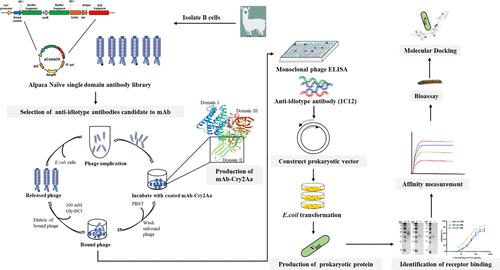当前位置:
X-MOL 学术
›
J. Agric. Food Chem.
›
论文详情
Our official English website, www.x-mol.net, welcomes your
feedback! (Note: you will need to create a separate account there.)
Screening and Identification of Anti-Idiotypic Nanobody Capable of Broad-Spectrum Recognition of the Toxin Binding Region of Lepidopteran Cadherins and Mimicking Domain II of Cry2Aa Toxin
Journal of Agricultural and Food Chemistry ( IF 5.7 ) Pub Date : 2024-01-15 , DOI: 10.1021/acs.jafc.3c07295
Cheng Shen 1, 2 , Jiafeng Jin 2 , Ziyan Huang 1, 2 , Meng Meng 1, 3 , Manman Lin 2 , Xiaodan Hu 2 , Qing Zhu 2, 3 , Chongxin Xu 2 , Wei Chen 2 , Johnson Lin 3 , Xiao Zhang 2 , Yuan Liu 2 , Xianjin Liu 1, 2
Journal of Agricultural and Food Chemistry ( IF 5.7 ) Pub Date : 2024-01-15 , DOI: 10.1021/acs.jafc.3c07295
Cheng Shen 1, 2 , Jiafeng Jin 2 , Ziyan Huang 1, 2 , Meng Meng 1, 3 , Manman Lin 2 , Xiaodan Hu 2 , Qing Zhu 2, 3 , Chongxin Xu 2 , Wei Chen 2 , Johnson Lin 3 , Xiao Zhang 2 , Yuan Liu 2 , Xianjin Liu 1, 2
Affiliation

|
The widespread use of Bacillus thuringiensis toxins as insecticides has brought about resistance problems. Anti-idiotypic nanobody approaches provide new strategies for resistance management and toxin evolution. In this study, the monoclonal antibody generated against the receptor binding region Domain II of Cry2Aa toxin was used as a target to screen materials with insecticidal activity. After four rounds of screening, anti-idiotypic nanobody 1C12 was obtained from the natural alpaca nanobody phage display library. To better analyze the activity of 1C12, soluble 1C12 was expressed by the Escherichia coli BL21 (DE3). The results showed that 1C12 not only binds the midgut brush border membrane vesicles (BBMV) of two lepidopteran species and cadherin CR9-CR11 of three lepidopteran species but also inhibits Cry2Aa toxins from binding to CR9-CR11. The insect bioassay showed that soluble 1C12 caused 25.65% and 23.61% larvae mortality of Helicoverpa armigera and Plutella xylostella, respectively. Although 1C12 has low insecticidal activity, soluble 1C12 possesses the ability to screen a broad-spectrum recognition of the toxin binding region of lepidopteran cadherins and can be used for the identification of the toxin binding region of other lepidopteran cadherins and the subsequent evolution of Cry2Aa toxin. The present study demonstrates a new strategy to screen for the production of novel insecticides.
中文翻译:

广谱识别鳞翅目钙粘蛋白毒素结合区和模拟Cry2Aa毒素结构域II的抗独特型纳米抗体的筛选和鉴定
苏云金芽孢杆菌毒素作为杀虫剂的广泛使用带来了耐药性问题。抗独特型纳米抗体方法为耐药性管理和毒素进化提供了新策略。本研究以针对Cry2Aa毒素受体结合区II域产生的单克隆抗体为靶点,筛选具有杀虫活性的材料。经过四轮筛选,从天然羊驼纳米抗体噬菌体展示库中获得抗独特型纳米抗体1C12。为了更好地分析1C12的活性,可溶性1C12由大肠杆菌BL21(DE3)表达。结果表明,1C12不仅能结合两种鳞翅目动物的中肠刷状缘膜囊泡(BBMV)和三种鳞翅目动物的钙粘蛋白CR9-CR11,而且还能抑制Cry2Aa毒素与CR9-CR11的结合。昆虫生物测定结果表明,可溶性1C12分别导致棉铃虫和小菜蛾幼虫死亡率为25.65%和23.61%。虽然1C12杀虫活性较低,但可溶性1C12具有筛选鳞翅目钙粘蛋白毒素结合区的广谱识别能力,可用于其他鳞翅目钙粘蛋白毒素结合区的鉴定以及Cry2Aa毒素的后续进化。本研究展示了一种筛选新型杀虫剂生产的新策略。
更新日期:2024-01-15
中文翻译:

广谱识别鳞翅目钙粘蛋白毒素结合区和模拟Cry2Aa毒素结构域II的抗独特型纳米抗体的筛选和鉴定
苏云金芽孢杆菌毒素作为杀虫剂的广泛使用带来了耐药性问题。抗独特型纳米抗体方法为耐药性管理和毒素进化提供了新策略。本研究以针对Cry2Aa毒素受体结合区II域产生的单克隆抗体为靶点,筛选具有杀虫活性的材料。经过四轮筛选,从天然羊驼纳米抗体噬菌体展示库中获得抗独特型纳米抗体1C12。为了更好地分析1C12的活性,可溶性1C12由大肠杆菌BL21(DE3)表达。结果表明,1C12不仅能结合两种鳞翅目动物的中肠刷状缘膜囊泡(BBMV)和三种鳞翅目动物的钙粘蛋白CR9-CR11,而且还能抑制Cry2Aa毒素与CR9-CR11的结合。昆虫生物测定结果表明,可溶性1C12分别导致棉铃虫和小菜蛾幼虫死亡率为25.65%和23.61%。虽然1C12杀虫活性较低,但可溶性1C12具有筛选鳞翅目钙粘蛋白毒素结合区的广谱识别能力,可用于其他鳞翅目钙粘蛋白毒素结合区的鉴定以及Cry2Aa毒素的后续进化。本研究展示了一种筛选新型杀虫剂生产的新策略。































 京公网安备 11010802027423号
京公网安备 11010802027423号